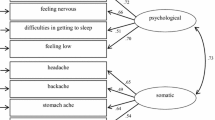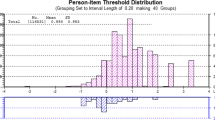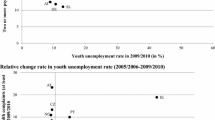Summary
BACKGROUND: This article describes changes in health complaints of Austrian adolescents during a period of 12 years. METHODS: The HBSC (Health Behaviour in School-aged Children) symptom checklist assesses how often specific physical and emotional symptoms occurred in the past 6 months. We display data collected in 1994, 1998, 2002 and 2006 for the whole sample (about 4500 students at each time point) as well as separated by age, gender and family affluence. RESULTS: The symptom load in Austrian adolescents decreased in the past 12 years slowly, but continuously. Boys and younger adolescents scored more favourably at all time points. Only in 2006, not at an earlier measurement time point, an impact of family affluence on symptom load could be detected. CONCLUSIONS: With the exception of the socioeconomic impact on symptom load in the year 2006, from an Austrian perspective, these results are favourable. The HBSC-data to be collected in 2010 will show if this trend continues to increase.
Zusammenfassung
GRUNDLAGEN: Ziel dieser Arbeit war es, die Prävalenzen von gesundheitlichen Beschwerden österreichischer Jugendlicher über einen Zeitraum von 12 Jahren abzubilden. METHODIK: Die HBSC (Health Behaviour in School-aged Children)-Beschwerdeliste erhebt, wie häufig bestimmte körperliche und psychische Beschwerden in den letzten 6 Monaten aufgetreten sind. Dargestellt werden die Ergebnisse zu 4 Messzeitpunkten (1994, 1998, 2002 und 2006) für die gesamte Stichprobe (jeweils etwa 4500 Schüler/-innen im Alter von 11 bis 15 Jahren) sowie getrennt nach Alter, Geschlecht und familiärem Wohlstandsniveau. ERGEBNISSE: Die Beschwerdelast von österreichischen Jugendlichen nimmt seit 12 Jahren langsam, aber stetig ab. Dass Mädchen und ältere Schüler/-innen mehr Beschwerden haben als Jungen bzw. jüngere Schüler/-innen, kann für alle Messzeitpunkte bestätigt werden. Erst 2006, nicht zu einem früheren Messzeitpunkt, zeigt sich, dass Jugendliche aus finanziell schlechter gestellten Familien eine signifikant höhere Beschwerdelast aufweisen. SCHLUSSFOLGERUNGEN: Mit Ausnahme des sozioökonomischen Impakts auf die Beschwerdelast im Jahr 2006, sind diese Ergebnisse aus österreichischer Sicht erfreulich. Die Daten aus der HBSC-Erhebung im Jahr 2010 werden zeigen, ob sich dieser Trend weiter verstärkt.
Similar content being viewed by others
Literatur
Bundesministerium für Familie, Senioren, Frauen und Jugend (2009) 13. Kinder- und Jugendbericht. http://www.bmfsfj.de/bmfsfj/generator/BMFSFJ/kinder-und-jugend,did=121936.html
Currie C, Gabhainn SN, Godeau E, et al. The Health Behaviour in School-aged Children: WHO Collaborative Cross-National (HBSC) Study: origins, concept, history and development 1982–2008. Int J Public Health, 54(Suppl 2): 131–139, 2009
Ravens-Sieberer U, Erhart M, Torsheim T, et al. An international scoring system for self-reported health complaints in adolescents. Eur J Public Health, 18: 294–299, 2008
Dür W, Griebler R. Die Gesundheit der österreichischen SchülerInnen im Lebenszusammenhang. Ergebnisse des 7. österreichischen WHO "Health Behaviour in School-aged Children" Survey. Mitteilungen der Sanitätsverwaltung, 11: 17–19, 2007
Cohen J. Statistical power analysis for the behavioral sciences. Hillsdale: Lawrence Erlbaum Associates, 1988
Cavallo F, Zambon A, Borraccino A, et al. Girls growing through adolescence have a higher risk of poor health. Qual Life Res, 15: 1577–1585, 2006
Hetland J, Torsheim T, Aaro LE. Subjective health complaints in adolescents: dimensional structure and variation across gender and age. Scand J Public Health, 30: 223–230, 2002
Ravens-Sieberer U, Torsheim T, Hetland J, et al. Subjective health, symptom load and quality of life of children and adolescents in Europe. Int J Public Health, 54(Suppl 2): 151–159, 2009
Boyce W, Torsheim T, Currie C, Zambon A. The Family Affluence Scale as a measure of national wealth: validation of an adolescent self-report. Soc Indicators Res, 78: 473–487, 2006
Ellert U, Neuhauser H, Roth-Isigkeit A. Schmerzen bei Kindern und Jugendlichen in Deutschland: Prävalenz und Inanspruchnahme medizinischer Leistungen. Bundesgesundheitsbl – Gesundheitsforsch – Gesundheitsschutz, 50: 711–717, 2007
Larsson B, Sund AM. Emotional/behavioural, social correlates and one-year predictors of frequent pains among early adolescents: influences of pain characteristics. Eur J Pain, 11: 57–65, 2007
Rhee H, Miles MS, Halpern CT, Holditch-Davis D. Prevalence of recurrent physical symptoms in U.S. adolescents. Pediatr Nurs, 31: 314–319, 2005
Hessel A, Geyer M, Schumacher J, Brähler E. Somatoforme Beschwerden bei Jugendlichen in Deutschland. Psychotherapeut, 48: 109–116, 2003
Holstein BE, Holme-Hansen E, Due P, Birna Almarsdóttir A. Self-reported medicine use among 11- to 15-year-old girls and boys in Denmark 1988–1998. Scand J Public Health, 31: 334–341, 2003
Perquin CW, Hazebroek-Kampschreur AA, Hunfeld JA, et al. Chronic pain among children and adolescents: physician consultation and medication use. Clin J Pain, 16: 229–235, 2000
Levin KA, Currie C, Muldoon J. Mental well-being and subjective health of 11- to 15-year-old boys and girls in Scotland, 1994–2006. Eur J Public Health, 19: 605–610, 2009
Land KC (2007) The Foundation for Child Development, Child and Youth Well-Being Index (CWI), 1975–2005, with Projections for 2006. http://www.fcd-us.org/usr_doc/2007CWIReport-Embargoed.pdf
WHO (2005) Der europäische Gesundheitsbericht 2005. Maßnahmen für eine bessere Gesundheit der Kinder und der Bevölkerung insgesamt. http://www.euro.who.int/
OECD (2009) Doing better for children. www.oecd.org/social/childwellbeing
Author information
Authors and Affiliations
Corresponding author
Rights and permissions
About this article
Cite this article
Dür, W., Griebler, R., Flaschberger, E. et al. Gesundheitliche Beschwerden österreichischer Jugendlicher – Ergebnisse der HBSC-Studie 1994 bis 2006. Wien Med Wochenschr 161, 174–179 (2011). https://doi.org/10.1007/s10354-010-0854-6
Received:
Accepted:
Published:
Issue Date:
DOI: https://doi.org/10.1007/s10354-010-0854-6




